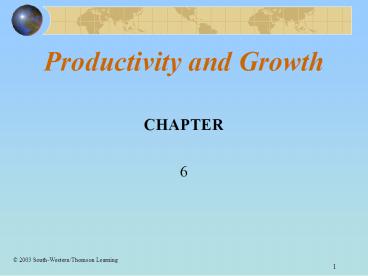Productivity and Growth - PowerPoint PPT Presentation
Title:
Productivity and Growth
Description:
the higher the productivity, the more goods and services that can be produced ... Labor Productivity ... Labor productivity equals real GDP divided by the ... – PowerPoint PPT presentation
Number of Views:406
Avg rating:3.0/5.0
Title: Productivity and Growth
1
Productivity and Growth
- CHAPTER
- 6
2003 South-Western/Thomson Learning
2
Causes of Economic Growth
- Increases in the availability of resources.
- Growth in labor supply.
- Growth in capital stock.
- Improvement in technology.
- Improvements in the rules of the game.
3
What is Productivity?
- Productivity
- measures how efficiently resources are employed
- the higher the productivity, the more goods and
services that can be produced from a given amount
of resources ? the farther out will be the PPF - total output divided by the amount of a
particular kind of resource employed
4
Labor Productivity
- Output per unit of labor and measures total
output divided by the hours of labor employed to
produce that output
5
Labor Productivity
- The resource most responsible for increasing
labor productivity is capital - Two broad categories of capital
- Human Capital
- Accumulated knowledge, skill, and experience of
the labor force - Physical Capital
- Includes the machines, buildings, roads,
airports, communication networks and other
manufactured creations used to produce goods and
services
6
Exhibit 2 Per-Worker Production Function
Expresses the relationship between the amount of
capital per worker (horizontal axis) and the
output per worker (vertical axis), other things
constant (level of technology and the rules of
the game)
Output per worker
7
Per Worker Production Function
- The shape of the per-worker production function
reflects the law of diminishing marginal returns - When applied to capital says that the more
capital per worker there is already, the less
additional output can be gained by increasing
capital stock per worker even more - An increase in the amount of capital per worker
is called capital deepening
8
Exhibit 3 Impact of a Technological Breakthrough
Technological change usually improves the quality
of capital and increases productivity, shown by
the upward rotation from PF to PF' ? more output
is produced at each level of capital per worker
k
9
Productivity / Growth in Practice
- Worlds economies can be sorted into two broad
groups - Industrial market countries or developed
countries - Developing or third-world countries
10
Industrial market countries
- Developed countries which make up about 20 of
the worlds population - Economically advanced capitalistic countries
- Western Europe, North America, Australia, New
Zealand, and Japan - Were the first to experience long-term economic
growth and have the highest standard of living
11
Developing Countries
- 80 of the worlds population
- Have a lower standard of living because of
relatively less human and physical capital - On average, the majority of workers in these
countries are employed in agriculture
12
Education and Economic Development
- Important source of productivity is the quality
of labor - Role of Education
- Education makes workers aware of the latest
production techniques - Makes workers more receptive to new ideas and
methods
13
Exhibit 4 Average Years of Education of
Working-Age Populations in 1970 and 1998
14
Exhibit 5 Long-Term Trend in U.S. Labor
Productivity Growth Annual Average by Decade
Average productivity growth since 1870 is 2.1
15
Exhibit 6 U.S. Labor Productivity Growth Slowed
During 1974 to 1982 and Then Rebounded
16
Output Per Capita
- Even if labor productivity did not increase,
total output would grow if the quantity of labor
increased - Labor productivity equals real GDP divided by the
quantity of labor ? real GDP equals labor
productivity times the quantity of labor
17
Output Per Capita
- Output per capita
- Real GDP divided by the population
- Best measure of economys standard of living
- Indicates how much an economy produces on average
per person
18
Output Per Capita
- Output per capita will increase if
- labor productivity increases for a given
worker-population ratio - the worker-population ratio increases for given
labor productivity - labor productivity and the worker-population both
increase
19
Exhibit 7 U.S. Real GDP per Capita Has Nearly
Tripled Since 1959
20
Exhibit 8 U.S. GDP Per Capita Is Highest of
Major Economies
21
Exhibit 9 U.S. Real GDP per Capita Outgrew Most
Other Major Economies Since 1982
22
Convergence Theory
- Convergence theory argues that developing
countries can grow faster than advanced ones ?
should eventually close the gap - It is easier to copy new technology once it is
developed than to develop new technology
23
Convergence Theory
- Reasons why the poorest countries have not
gained - Birth rates are nearly double those in richer
ones - Vast differences in the quality of human capital
across countries - Some countries lack the stable macroeconomic
environment, established institutions, and
infrastructures needed to nurture economic growth

